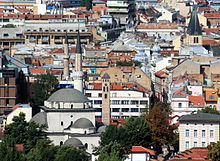Gazi Husrev Beg Mosque
The Gazi-Husrev-Beg Mosque ( Husrev-Begova džamija , Turkish Gazi Hüsrev Bey Camii ), also shortened to Begova Mosque ( Begova džamija ) from 1530/31 (building inscription) in Sarajevo is the largest and one of the oldest mosques in Bosnia and Herzegovina .
history
It was commissioned by Gazi Husrev Beg (Turkish: Hüsrev Beğ / Bey), a nephew of Sultan Bayezid II., During the time of the court architect Acem Esir Ali (also: Alaüddin, Acem Alisi), the predecessor of the famous Mimar Sinan . As with many other major projects of the time, craftsmen from Ragusa ( Dubrovnik ) were also involved in the construction.
The Gazi Husrev Beg Mosque is a dome mosque in the early classical style with a dome and semi-dome over the prayer room. The main prayer room has a square floor plan with a side length of 13 meters; the top of the dome above is 26 meters. The mosque has a front aisle with a semi-dome and two side aisles. The arcades of the vestibule rests on four marble columns with capitals . The minaret is 47 meters high. In the courtyard of the mosque there is a fountain ( šedrvan , Turkish şadırvan ), the mausoleums (turben) of Gazi Huzrev Beg and Gazi Murat Beg and several tombs, including those of Mehmed Spaho .
Medresa (religious school)
In 1537 an Islamic college was built opposite the mosque . It also has an inner courtyard with a fountain and an arcade hall, which is covered by ten domes. The interior is located under 14 other domes. In the vernacular, the medresa is called kuršumlija (from Turkish kurşun for “lead”) because of the lead-covered roof . Today, as the facility has become too small, this building no longer serves its purpose. A new medresa and the Islamic theological faculty were built on its right side a few years ago.
Šadrvan
In the middle of the mosque courtyard rises a graceful Šadrvan ( mosque fountain ), the roof of which stands on eight sleek columns connected by arches. Husref Beg led the water through wooden pipes from the spring 6 km from Sarajevo to the fountain and distributed it in what was then Sarajevo. When it is very cold in winter, the ablution is performed in a special room.
Muvekithana
In the northwest corner of the mosque courtyard there is a small room, the so-called Muvekithana, which has instruments for measuring the position of the sun. The sunset falls precisely at 12 o'clock according to "a la turca" time and then the time is determined for the start of the five daily prayers.
Sahat Kula
Outside the mosque courtyard, in the immediate vicinity of the mosque, there is the high clock tower "Sahat Kula", the old public clock. It is not known when the Sahat Kula was built, but it is first mentioned around the 17th century. The clocks are placed on all four sides and show the time starting with sunset.
gallery
literature
- Lazar Trifunović: Art Monuments in Yugoslavia. Volume 2 (P – Z), Edition Leipzig 1981
- Ghazi Husrev-Beg's manuscript on the foundation (available at the mosque's visitor house)
Web links
Coordinates: 43 ° 51 ′ 33 " N , 18 ° 25 ′ 44.5" E





